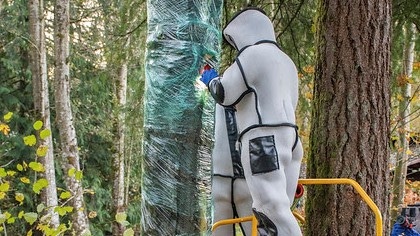
Tracking animals certainly isn’t new in agriculture or in wildlife science. Radio signal-emitting ear tags help ranchers and auction yards identify cattle, and we all remember the story of OR-7, the lone gray wolf that roamed into California with a tracking device that enabled wildlife officials to watch its every move.
But tracking the movements of individual insects? It’s being done, and the technology recently helped Washington state agricultural officials find the first known Asian giant hornet’s nest in the U.S. The nest was found and removed Oct. 24 in Blaine, Wash., near where the first single dead hornet was found Dec. 9, 2019.
Dubbed the “murder hornet” by media, the AGH – Vespa mandarina – quickly became an object of apocalyptic 2020 lore. The specimens in the University of California, Davis’ Bohart Museum of Entomology are about 1.5 inches long. “I’ve never seen one 2 inches long,” museum director Lynn Kimsey said in a podcast. “But it’s a big animal – no question about it.”
Kimsey believes much of the media hysteria over the insect is overblown. Though the hornet can sting repeatedly and “deliver a lot of venom,” a honey bee’s sting is worse, she said.
But while it may not be a “murder hornet” to humans, it is for bees. As the USDA explains, Asian giant hornets can attack honey bee hives, then take the hive’s bee larvae and pupae back to their nest to feed their own brood. They’re most prone to attack in the late summer and early fall.
So Washington State Department of Agriculture entomologists had a plan: Capture a live hornet, attach a radio tag to it, release it, and track the radio tag back to its nest. All is easier said than done. For one thing, they needed a way to attach the radio tag securely without harming the hornet. They also needed a strong enough signal to track the tag, adequate battery life for the operation and the ability to move through rough terrain with the tracking equipment, a USDA release explains.
Fortunately, a USDA Animal and Plant Health Inspection Service lab in Massachusetts has developed expertise in using radio tags on insects. “For two years, APHIS scientists have been attaching radio tags to the spotted lanternfly to study their movements,” agency entomologist Miriam Cooperband said. The pest can attack many tree species and crops, she said.
“The tags worked well for us, and we were happy to offer them to our Washington state colleagues, along with the antenna, receiver and tutorials,” she said.
Now that scientists have shown that it’s possible to find and eradicate a nest, the hunt continues for any other AGH nests that might be in the area. The live specimens from the nests will help researchers learn more about the insect, including how to protect honey bees from their sting.
The wonder of science is a gift to agriculture.
About the Author(s)
You May Also Like






